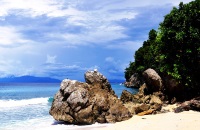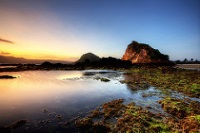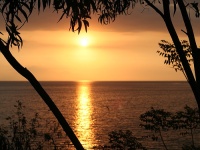
Ampenan-Mataram-Cakranegara-Sweta, or more simply referred to as Ampenan, is a vibrant district located on Indonesia's lush Lombok Island. The sprawling metropolis is comprised of four towns, the boundaries of which are indistinguishable to the casual visitor, and is host to a population of around 250,000 people. While Sweta is the main transport hub and site of the island's biggest market, it is bustling Ampenan, the old port town furthest west, that is the main tourist area and the location of most shops, hotels and restaurants.Most visitors pass through the area fairly quickly but there are one or two sights worth seeing nearby, including the weaving factories in the capital Mataram, whose processes have remained largely unchanged for hundreds of years, and a weaving village to the south where traditionally dressed women work on wooden handlooms. There are a number of shrines and temples open to visitors, the best of which are centred around the Mayura Water Palace, dating from 1744 and used by the royal court during the Balinese rule of Lombok.Ampenan, being an old port town, has a beach still lined with hundreds of fishing canoes. As the fishermen mostly go out at night, it is fun to watch the boats setting off in the late afternoon, and seeing the sun set over the water. Ampenan's market, which is the areas primary attraction, is located along the main road to Senggigi, north of the city proper. The Pura Segara Balinese temple is close by on the beach.

Situated a few miles off the northwest coast of Lombok, the three Gili Islands - Gili Trawangan, Gili Meno and Gili Air - were 'discovered' by backpackers in the 80s and until recently remained a laid-back haven for budget travellers in search of a peaceful and secluded holiday paradise. The islands are surrounded by glorious soft sandy beaches, colourful coral reefs and crystal clear turquoise waters, ideal for diving.There are almost no roads or motor vehicles on the islands, with scooters and donkey-drawn carts acting as their replacements. Small ferries transport guests between the Gili Islands, none of which are more than twenty minutes apart. Most of the holiday accommodation is on Gili Trawangan, and this generally consists of small bamboo bungalows a few metres from the beach, like those found on Thailand's islands twenty years ago.Mainstream tourism is beginning to establish itself on the Gili Islands and a few exclusive hotels have opened up, most recently on the smallest, least developed island of Gili Meno. While there are no major sights or landmarks to see, the scuba diving and snorkelling opportunities are enough to make it a popular destination and the atmosphere and scenery are splendid enough to enchant visitors.

The city of Jayapura is often the first stop for travellers to Papua, but even so its remoteness is such that many of the visiting Westerners are thought to be either mine workers or missionaries. Although the wilds of Papua are a quick trail away, the city itself provides visitors with reasons to stay. Beautiful beaches and bays stretch below thick jungle hills and some of these contain remnants of WWII landing crafts, just as some of the caves in the area are said to retain Japanese skeletons from the war. The nicest swimming beach is Base G, with aqua blue water and a palmed shoreline. Nightly arrays of seafood tents are erected, allowing eaters to pick their favourite fish to barbecue.The mix of Indonesian immigrants and Papuan locals seem to get along well in Jayapurna, despite being somewhat locked in conflict elsewhere in Papua. The city is deeply religious and a normal greeting often asks visitors to describe their faith. This also means there is a general lack of nightlife, although the occasional pool hall serves expensive beer and offers free karaoke. There are a number of mid-range hotels and one or two luxury options for accommodation. Papua New Guinea is a hop and a skip away and visas and transport can be arranged in Jayapura.

Not to be confused with its better-known namesake on Bali, Lombok's Kuta is almost totally undeveloped by comparison, having only been 'discovered' by surfers a few years ago and still devoid of any large holiday resort hotels. The whole south coast is characterised by miles of stunning curved sandy bays set beneath empty, rolling hills. There are plans for development but that is still many years away, to the delight of many tourists who prefer to explore Indonesia's undeveloped coastlines.Kuta's southeast peninsula and Awang Bay are dotted with tiny fishing villages untouched by tourism, while inland villages specialising in local crafts such as pottery, weaving, basket ware and carving can be visited. There are bars and restaurants in the town, but no ATMs, and internet is patchy. Locals sell crafts like hand-woven sarongs and even pearl jewellery and they can be a bit persistent and annoying if you don't buy from them - but generally the lack of crowds and touristy stalls is a refreshing change from the most popular areas of Indonesia which have been thronged by tourists. Kuta Lombok is still relatively rustic and unspoiled so it is ideal for those travellers who don't mind foregoing luxury and the occasional convenience to experience a place that still feels like a secluded island paradise.

Just a few miles south of Ampenan, Senggigi is the most developed holiday resort on Lombok, characterised by broad bays, towering headlands and first-rate hotels and restaurants, and boasting the only real nightlife in Lombok. Being close to the airport it makes a good first or last night stop for those intent on exploring the island. The drive north along the coast from Senggigi to Pemenang is a great day out for those with a car, offering spectacular views of the Gili Islands and across to Bali when the weather is clear. The twisting road takes holiday visitors to an expanse of coast that is totally undeveloped with only a few coastal villages dotted behind sweeping bays of turquoise water and palm trees.Just south of Senggigi is the Batu Bolong Temple. Weighed down under an excess of lurid pink paint, its shrines are spread around a rocky promontory with fabulous views in both directions along the coast. The main part of the temple is built over an archway in the rock, a hole through which virgins were once supposedly sacrificed to appease the gods. Today this is a quiet and peaceful spot and a favourite with local fishermen. Spear fishing is a popular activity, along with scuba diving, snorkelling, hiking, and cycling.

Travel Guide powered by Word Travels, copyright © 2023 Globe Media Ltd. By its very nature information in this travel guide is subject to change at short notice and travellers are urged to verify information on which they're relying with the relevant authorities. Neither Globe Media Ltd nor Travel Vogue can accept any responsibility for any loss or inconvenience to any person as a result of information contained above.